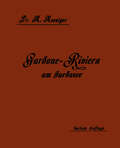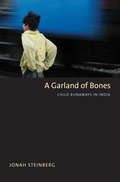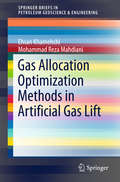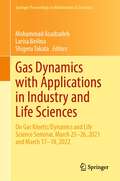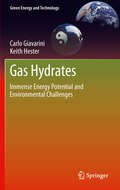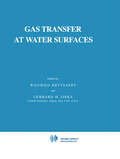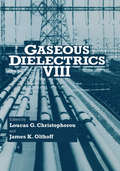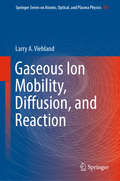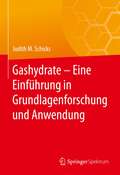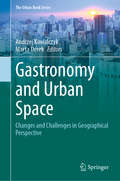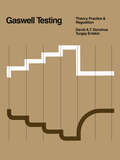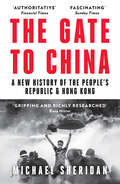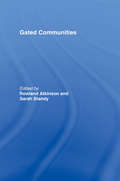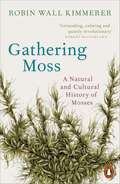- Table View
- List View
Gardone-Riviera am Gardasee als Winterkurort
by Karl KoenigerDieser Buchtitel ist Teil des Digitalisierungsprojekts Springer Book Archives mit Publikationen, die seit den Anfängen des Verlags von 1842 erschienen sind. Der Verlag stellt mit diesem Archiv Quellen für die historische wie auch die disziplingeschichtliche Forschung zur Verfügung, die jeweils im historischen Kontext betrachtet werden müssen. Dieser Titel erschien in der Zeit vor 1945 und wird daher in seiner zeittypischen politisch-ideologischen Ausrichtung vom Verlag nicht beworben.
A Garland of Bones: Child Runaways in India (Yale Agrarian Studies Series)
by Jonah SteinbergAn intimate portrait of India’s child runaways, and the sociopolitical forces shaping their lives This intimate portrait examines the tracks, journeys, and experiences of child runaways in northern India. Jonah Steinberg situates children’s decisions to leave home and flee for the city in their larger cultural, social, and historical contexts, and considers histories of landlessness and debt servitude in narratives of child dislocation. The resulting work is an original perspective on the sociological trends in postcolonial India and a unique treatment of a population of individuals who live on the margin of society.
Gas Allocation Optimization Methods in Artificial Gas Lift (SpringerBriefs in Petroleum Geoscience & Engineering)
by Ehsan Khamehchi Mohammad Reza MahdianiThis Brief offers a comprehensive study covering the different aspects of gas allocation optimization in petroleum engineering. It contains different methods of defining the fitness function, dealing with constraints and selecting the optimizer; in each chapter a detailed literature review is included which covers older and important studies as well as recent publications. This book will be of use for production engineers and students interested in gas lift optimization.
Gas Dynamics with Applications in Industry and Life Sciences: On Gas Kinetic/Dynamics and Life Science Seminar, March 25–26, 2021 and March 17–18, 2022 (Springer Proceedings in Mathematics & Statistics #429)
by Mohammad Asadzadeh Larisa Beilina Shigeru TakataThis proceedings volume gathers selected contributions presented at two instances of the "JSPS/SAC Seminar: On Gas Kinetic/Dynamics and Life Science", held by the Chalmers University of Technology and University of Gothenburg, Sweden, on March 25-26, 2021 (virtual) and March 17-18, 2022 (virtual).Works in this book provide a concise approach to the theoretical and numerical analysis of kinetic type equations that arise, for example, in modeling industrial, medical, and environmental problems. Readers will find some of the most recent theoretical results, newly developed numerical methods in the field, and some open problems. Possible application areas encompass fission/fusion energy, electromagnetics, nuclear science and engineering, medical service, radiation oncology, and plants growth conditions, to name a few. The JSPS/SAC seminars are jointly organized by JSPS (Japan Society for the Promotion of Science)—Stockholm Office and the Department of Mathematical Sciences, Chalmers University of Technology & University of Gothenburg, Sweden. These seminars foster discussions on the mathematical theory, industrial and life science applications, and numerical analysis of non-linear hyperbolic partial differential equations modeling collision-less plasma and charged particles.Chapter 4 is available open access under a Creative Commons Attribution 4.0 International License via link.springer.com.Chapter 11 is available open access under a Creative Commons Attribution 4.0 International License via link.springer.com.
Gas Hydrates: Immense Energy Potential and Environmental Challenges (Green Energy and Technology)
by Carlo Giavarini Keith HesterGas hydrates are both a huge energy resource and an environmental challenge. They have a significant impact on society because of their applications to the future of energy, protection of the environment and fuel transportation.Gas Hydrates opens up this fascinating, multidisciplinary field to non-specialists. It provides a scientific study of gas hydrates that considers their potential as an energy source while assessing the possible risk to the environment. The authors also examine the feasibility of using these natural compounds for storing and transporting gases such as methane and carbon dioxide. Diagrams and photos are used throughout Gas Hydrates to help readers understand the scientific and technical content. Each section has been designed so it can be read independently by academics and professionals in the oil and gas industry, as well as by all those with an interest in how hydrates combine to be an energy resource, an industrial challange and a geological hazard.
Gas Transfer at Water Surfaces (Water Science and Technology Library #2)
by Wilfried Brutsaert Gerhard H. JirkaThe transfer across the surface of environmental waters is of interest as an important phase in the geophysical and natural biochemical cycles of numer ous substances; indeed it governs the transition, one way or the other, be tween the dissolved state in the water and the gaseous state in the atmo sphere. Especially with increasing population and industrialization, gas transfer at water surfaces has become a critical factor in the understanding of the various pathways of wastes in the environment and of their engineering management. This interfacial mass transfer is, by its very nature, highly complex. The air and the water are usually in turbulent motion, and the interface be tween them is irregular, and disturbed by waves, sometimes accompanied by breaking, spray and bubble formation. Thus the transfer involves a wide variety of physical phenomena occurring over a wide range of scales. As a consequence, scientists and engineers from diverse disciplines and problem areas, have approached the problem, often with greatly differing analytical and experimental techniques and methodologies.
Gas Transport in Porous Media (Theory and Applications of Transport in Porous Media #20)
by Clifford K. Ho Stephen W. WebbCLIFFORD K. HOAND STEPHEN W. WEBB Sandia National Laboratories, P. O. Box 5800, Albuquerque, NM 87185, USA Gas and vapor transport in porous media occur in a number of important applications includingdryingofindustrialandfoodproducts,oilandgasexploration,environm- tal remediation of contaminated sites, and carbon sequestration. Understanding the fundamental mechanisms and processes of gas and vapor transport in porous media allows models to be used to evaluate and optimize the performance and design of these systems. In this book, gas and vapor are distinguished by their available states at stan- ? dard temperature and pressure (20 C, 101 kPa). If the gas-phase constituent can also exist as a liquid phase at standard temperature and pressure (e. g. , water, ethanol, toluene, trichlorothylene), it is considered a vapor. If the gas-phase constituent is non-condensable at standard temperature and pressure (e. g. , oxygen, carbon di- ide, helium, hydrogen, propane), it is considered a gas. The distinction is important because different processes affect the transport and behavior of gases and vapors in porous media. For example, mechanisms specific to vapors include vapor-pressure lowering and enhanced vapor diffusion, which are caused by the presence of a g- phase constituent interacting with its liquid phase in an unsaturated porous media. In addition, the “heat-pipe” exploits isothermal latent heat exchange during evaporation and condensation to effectively transfer heat in designed and natural systems.
Gaseous Dielectrics VIII
by Loucas G. Christophorou James K. OlthoffGaseous Dielectrics VIII covers recent advances and developments in a wide range of basic, applied, and industrial areas of gaseous dielectrics.
Gaseous Ion Mobility, Diffusion, and Reaction (Springer Series on Atomic, Optical, and Plasma Physics #105)
by Larry A. ViehlandThis book is about the drift, diffusion, and reaction of ions moving through gases under the influence of an external electric field, the gas temperature, and the number density. While this field was established late in the 19th century, experimental and theoretical studies of ion and electron swarms continue to be important in such varied fields as atomic and molecular physics, aeronomy and atmospheric chemistry, gaseous electronics, plasma processing, and laser physics. This book follows in the rigorous tradition of well-known older books on the subject, while at the same time providing a much-needed overview of modern developments with a focus on theory. Graduate students and researchers new to this field will find this book an indispensable guide, particularly those involved with ion mobility spectrometry and the use of ion transport coefficients to test and improve ab initio ion-neutral interaction potentials. Established researchers and academics will find in this book a modern companion to the classic references.
Gashydrate – Eine Einführung in Grundlagenforschung und Anwendung
by Judith M. SchicksGashydrate, auch „brennendes Eis“ genannt, sind faszinierende, eisähnliche Feststoffe, die aus Wasser- und Gasmolekülen aufgebaut sind und weltweit an allen aktiven und passiven Kontinentalhängen und in Permafrostgebieten vorkommen. Doch ihr unauffälliges Erscheinungsbild täuscht: Die Einschlussverbindungen können beachtliche Mengen Methangas enthalten. Daher besteht einerseits die Hoffnung auf einen möglichen neuen Energieträger und andererseits die Sorge um eine nicht zu unterschätzende Quelle an klimaschädlichem Methangas. Gashydrate, hat die neueste Forschung gezeigt, bieten zudem in vielen Bereichen industrieller Anwendung eine durchaus vielversprechende Alternative zu konventionellen Verfahren.Das vorliegende Buch gibt eine Einführung in die physikalisch-chemischen Grundlagen der Hydratbildung und die Strukturen der Gashydratphasen. Basierend auf diesem grundlegenden Verständnis erklärt es die natürlichen Gashydratvorkommen und zeichnet mögliche Methoden des Abbaus und der Gewinnung von Methangas auf. Es beleuchtet Risiken, die von den Gashydratvorkommen in der Natur ausgehen könnten, und führt in die Möglichkeiten der Nutzung dieser Einschlussverbindungen in verschiedenen industriellen Anwendungsbereichen wie z.B. der Aufbereitung von Abwässern oder der Speicherung von Gasen ein.Zielgruppe dieser kompakten Einführung in die verschiedenen Aspekte der Gashydratforschung sind Studierende der Chemie und Geowissenschaften, Ingenieure, Techniker oder auch Wissenschaftler.
Gastronomy and Urban Space: Changes and Challenges in Geographical Perspective (The Urban Book Series)
by Andrzej Kowalczyk Marta DerekThis book focuses on the relationship between gastronomy and urban space. It highlights the intrinsic role of eating establishments and the gastronomy industry for cities by assessing their huge impacts on urban changes and discussing some of the challenges posed by new developments.Written by authors with a background in geography, it starts by discussing theoretical aspects of studies on gastronomy in urban space to place the subject in the broader context of urban geography. Covering both changes and challenges in gastronomy in urban space, it presents a wide range of problems, which are described and analysed using various case studies from Europe and other parts of the world.
Gastrospaces: A Philosophical Study of Where We Eat (Critical Food Studies)
by Matteo Bonotti Andrea Borghini Nicola Piras Beatrice SeriniThis book explores the moral and political significance of gastrospaces: the spaces where we eat. It adopts an innovative approach, combining analytic political philosophy and analytic ontology, to lay down the theoretical foundations for a multi- and interdisciplinary research agenda on the complex interconnections between food and space.Social science and humanities scholars have studied the ties between food consumption and space from multiple angles. This book sets up a different and more foundational approach, which engages with these bodies of work and integrates them into a coherent framework. While taking the reader through a theoretical journey of varying complexities, the book also illustrates the social, political, and cultural significance of gastrospaces by surveying an array of examples from diverse historical and geographical contexts. It then draws on political philosophy to show that gastrospaces are sites of justice and injustice and complements this analysis by developing an ontological model for gastrospaces that facilitates a systematic analysis of their social, political, and cultural significance. The book ends with a toolbox for the study of gastrospaces that different stakeholders may apply to their respective contexts of intervention.This book will appeal to philosophers, political scientists, food scholars, geographers, and anyone interested in the intersection between food and space. By focusing on a wide range of real-world topics related to gastrospaces, such as racist dress codes, family-friendly restaurants, speakeasies, and gendered kitchen designs, the book will also be of interest to nonacademic stakeholders such as urban planners, policymakers, designers, managers, and consumers.
Gastrospaces: A Philosophical Study of Where We Eat (Critical Food Studies)
by Matteo Bonotti Andrea Borghini Nicola Piras Beatrice SeriniThis book explores the moral and political significance of gastrospaces: the spaces where we eat. It adopts an innovative approach, combining analytic political philosophy and analytic ontology, to lay down the theoretical foundations for a multi- and interdisciplinary research agenda on the complex interconnections between food and space.Social science and humanities scholars have studied the ties between food consumption and space from multiple angles. This book sets up a different and more foundational approach, which engages with these bodies of work and integrates them into a coherent framework. While taking the reader through a theoretical journey of varying complexities, the book also illustrates the social, political, and cultural significance of gastrospaces by surveying an array of examples from diverse historical and geographical contexts. It then draws on political philosophy to show that gastrospaces are sites of justice and injustice and complements this analysis by developing an ontological model for gastrospaces that facilitates a systematic analysis of their social, political, and cultural significance. The book ends with a toolbox for the study of gastrospaces that different stakeholders may apply to their respective contexts of intervention.This book will appeal to philosophers, political scientists, food scholars, geographers, and anyone interested in the intersection between food and space. By focusing on a wide range of real-world topics related to gastrospaces, such as racist dress codes, family-friendly restaurants, speakeasies, and gendered kitchen designs, the book will also be of interest to nonacademic stakeholders such as urban planners, policymakers, designers, managers, and consumers.
Gaswell Testing: Theory, Practice & Regulation
by David A.T. Donohue T. ErtekIntroduction 1 1. Conventional & Isochronal Tests 5 1. 1 Derivation of Fundamental Flow Equation 6 1. 2 Conventional Test 10 1. 3 Isochronal Test 13 1. 4 Modified Isochronal Test 17 2. Additional Testing Options 23 2. 1 Pseudopressure (Real Gas Potential) Treatment for Gas Flow 24 2. 2 The Radial Diffusivity Equation for Gas Flow 31 2. 3 Analytical Solution of the Diffusivity Equation 33 2. 4 Flow Regimes 34 2. 5 Skin Factor 36 2. 6 Turbulent Flow Factor 40 2. 7 Drawdown or Falloff Test 41 2. 8 Buildup Test 43 2. 9 Determination of S, S' and 0 from Buildup and Drawdown Tests 47 53 3. Additional Testing Considerations 3. 1 Surface-Pressure Relationships 54 Stabilization Time and Radius of Investigation 62 3. 2 Choice of Flow Rates and Duration of Flow Rates 64 3. 3 3. 4 Well bore Storage Effects 65 3. 5 Production of Liquids 66 3. 6 Single-Point Test 68 3. 7 The Orifice Meter 68 3. 8 Testing Equipment 74 76 3. 9 Measurement, Sampling, and Safety in Testing 81 4. Procedures & Regulations 4. 1 Interstate Oil Compact Commission Procedures 83 4. 2 State of Texas Regulations 99 4. 3 State of Oklahoma Regulations 102 4. 4 State of New Mexico Regulations 109 4. 5 State of Louisiana Regulations 123 4. 6 Province of Alberta Regulations 124 vi Gaswell Testing 5. Field Test & Interpretation 127 6.
The Gate to China: A New History Of The People's Republic And Hong Kong
by Michael Sheridan‘A delightful piece of writing and research which describes the remarkable history behind the handover of this unique and exciting city’ Jasper Becker ‘Deeply researched and beautifully written’ Mike Chinoy A superb new history of the rise of China and the fall of Hong Kong to authoritarian rule.
Gated Communities: International Perspectives
by Rowland Atkinson Sarah BlandyThis informative volume gathers contemporary accounts of the growth, influences on, and impacts of so-called gated communities, developments with walls, gates, guards and other forms of surveillance. While gated communities have become a common feature of the urban landscape in South Africa, Latin and North America, it is also clear that there is now significant interest in gated living in the European and East Asian urban context. The chapters in this book investigate issues and communities such as: gated communities in the metropolitan area of Buenos Aires, Argentina planning responses to gated communities in Canada who segregates whom? The analysis of a gated community in Mendoza, Argentina sprawl and social segregation in southern California. These illustrative chapters enable the reader to understand more about the social and economic forces that have lead to gating, the ways in which gated communities are managed, and their wider effects on both residents and those living outside the gates. This book was previously published as a special issue of the journal Housing Studies.
Gated Communities: International Perspectives
by Rowland Atkinson Sarah BlandyThis informative volume gathers contemporary accounts of the growth, influences on, and impacts of so-called gated communities, developments with walls, gates, guards and other forms of surveillance. While gated communities have become a common feature of the urban landscape in South Africa, Latin and North America, it is also clear that there is now significant interest in gated living in the European and East Asian urban context. The chapters in this book investigate issues and communities such as: gated communities in the metropolitan area of Buenos Aires, Argentina planning responses to gated communities in Canada who segregates whom? The analysis of a gated community in Mendoza, Argentina sprawl and social segregation in southern California. These illustrative chapters enable the reader to understand more about the social and economic forces that have lead to gating, the ways in which gated communities are managed, and their wider effects on both residents and those living outside the gates. This book was previously published as a special issue of the journal Housing Studies.
Gateway Cities in Global Production Networks: Insights from the Oil and Gas Industry in Southeast Asia (Economic Geography)
by Moritz BreulThis book provides a comprehensive analysis of the role of gateway cities in contemporary circuits of global production. Apart from facilitating the interlinking of economic activities in the surrounding regions with the global economy, gateway cities have enormous implications for how certain regions participate in the global economy. Based on a case study of the oil and gas industry in Southeast Asia the book maps gateway cities, explores why these cities have come to occupy a gateway role, and evaluates their implications for regional economic development. To this aim, the book links components from research on the World City Network with Global Production Network research and demonstrates how this intersection creates synergies for studying the role of cities in economic globalization. The main audiences that this book appeals to are researchers and students interested in debates on regional development and the role of cities in the global economy. The book is also attractive to scholars interested in the organization of extractive industries.
The Gateway to the Pacific: Japanese Americans and the Remaking of San Francisco (Historical Studies of Urban America)
by Meredith OdaIn the decades following World War II, municipal leaders and ordinary citizens embraced San Francisco’s identity as the “Gateway to the Pacific,” using it to reimagine and rebuild the city. The city became a cosmopolitan center on account of its newfound celebration of its Japanese and other Asian American residents, its economy linked with Asia, and its favorable location for transpacific partnerships. The most conspicuous testament to San Francisco’s postwar transpacific connections is the Japanese Cultural and Trade Center in the city’s redeveloped Japanese-American enclave. Focusing on the development of the Center, Meredith Oda shows how this multilayered story was embedded within a larger story of the changing institutions and ideas that were shaping the city. During these formative decades, Oda argues, San Francisco’s relations with and ideas about Japan were being forged within the intimate, local sites of civic and community life. This shift took many forms, including changes in city leadership, new municipal institutions, and especially transformations in the built environment. Newly friendly relations between Japan and the United States also meant that Japanese Americans found fresh, if highly constrained, job and community prospects just as the city’s African Americans struggled against rising barriers. San Francisco’s story is an inherently local one, but it also a broader story of a city collectively, if not cooperatively, reimagining its place in a global economy.
The Gateway to the Pacific: Japanese Americans and the Remaking of San Francisco (Historical Studies of Urban America)
by Meredith OdaIn the decades following World War II, municipal leaders and ordinary citizens embraced San Francisco’s identity as the “Gateway to the Pacific,” using it to reimagine and rebuild the city. The city became a cosmopolitan center on account of its newfound celebration of its Japanese and other Asian American residents, its economy linked with Asia, and its favorable location for transpacific partnerships. The most conspicuous testament to San Francisco’s postwar transpacific connections is the Japanese Cultural and Trade Center in the city’s redeveloped Japanese-American enclave. Focusing on the development of the Center, Meredith Oda shows how this multilayered story was embedded within a larger story of the changing institutions and ideas that were shaping the city. During these formative decades, Oda argues, San Francisco’s relations with and ideas about Japan were being forged within the intimate, local sites of civic and community life. This shift took many forms, including changes in city leadership, new municipal institutions, and especially transformations in the built environment. Newly friendly relations between Japan and the United States also meant that Japanese Americans found fresh, if highly constrained, job and community prospects just as the city’s African Americans struggled against rising barriers. San Francisco’s story is an inherently local one, but it also a broader story of a city collectively, if not cooperatively, reimagining its place in a global economy.
The Gateway to the Pacific: Japanese Americans and the Remaking of San Francisco (Historical Studies of Urban America)
by Meredith OdaIn the decades following World War II, municipal leaders and ordinary citizens embraced San Francisco’s identity as the “Gateway to the Pacific,” using it to reimagine and rebuild the city. The city became a cosmopolitan center on account of its newfound celebration of its Japanese and other Asian American residents, its economy linked with Asia, and its favorable location for transpacific partnerships. The most conspicuous testament to San Francisco’s postwar transpacific connections is the Japanese Cultural and Trade Center in the city’s redeveloped Japanese-American enclave. Focusing on the development of the Center, Meredith Oda shows how this multilayered story was embedded within a larger story of the changing institutions and ideas that were shaping the city. During these formative decades, Oda argues, San Francisco’s relations with and ideas about Japan were being forged within the intimate, local sites of civic and community life. This shift took many forms, including changes in city leadership, new municipal institutions, and especially transformations in the built environment. Newly friendly relations between Japan and the United States also meant that Japanese Americans found fresh, if highly constrained, job and community prospects just as the city’s African Americans struggled against rising barriers. San Francisco’s story is an inherently local one, but it also a broader story of a city collectively, if not cooperatively, reimagining its place in a global economy.
The Gateway to the Pacific: Japanese Americans and the Remaking of San Francisco (Historical Studies of Urban America)
by Meredith OdaIn the decades following World War II, municipal leaders and ordinary citizens embraced San Francisco’s identity as the “Gateway to the Pacific,” using it to reimagine and rebuild the city. The city became a cosmopolitan center on account of its newfound celebration of its Japanese and other Asian American residents, its economy linked with Asia, and its favorable location for transpacific partnerships. The most conspicuous testament to San Francisco’s postwar transpacific connections is the Japanese Cultural and Trade Center in the city’s redeveloped Japanese-American enclave. Focusing on the development of the Center, Meredith Oda shows how this multilayered story was embedded within a larger story of the changing institutions and ideas that were shaping the city. During these formative decades, Oda argues, San Francisco’s relations with and ideas about Japan were being forged within the intimate, local sites of civic and community life. This shift took many forms, including changes in city leadership, new municipal institutions, and especially transformations in the built environment. Newly friendly relations between Japan and the United States also meant that Japanese Americans found fresh, if highly constrained, job and community prospects just as the city’s African Americans struggled against rising barriers. San Francisco’s story is an inherently local one, but it also a broader story of a city collectively, if not cooperatively, reimagining its place in a global economy.
The Gateway to the Pacific: Japanese Americans and the Remaking of San Francisco (Historical Studies of Urban America)
by Meredith OdaIn the decades following World War II, municipal leaders and ordinary citizens embraced San Francisco’s identity as the “Gateway to the Pacific,” using it to reimagine and rebuild the city. The city became a cosmopolitan center on account of its newfound celebration of its Japanese and other Asian American residents, its economy linked with Asia, and its favorable location for transpacific partnerships. The most conspicuous testament to San Francisco’s postwar transpacific connections is the Japanese Cultural and Trade Center in the city’s redeveloped Japanese-American enclave. Focusing on the development of the Center, Meredith Oda shows how this multilayered story was embedded within a larger story of the changing institutions and ideas that were shaping the city. During these formative decades, Oda argues, San Francisco’s relations with and ideas about Japan were being forged within the intimate, local sites of civic and community life. This shift took many forms, including changes in city leadership, new municipal institutions, and especially transformations in the built environment. Newly friendly relations between Japan and the United States also meant that Japanese Americans found fresh, if highly constrained, job and community prospects just as the city’s African Americans struggled against rising barriers. San Francisco’s story is an inherently local one, but it also a broader story of a city collectively, if not cooperatively, reimagining its place in a global economy.
The Gateway to the Pacific: Japanese Americans and the Remaking of San Francisco (Historical Studies of Urban America)
by Meredith OdaIn the decades following World War II, municipal leaders and ordinary citizens embraced San Francisco’s identity as the “Gateway to the Pacific,” using it to reimagine and rebuild the city. The city became a cosmopolitan center on account of its newfound celebration of its Japanese and other Asian American residents, its economy linked with Asia, and its favorable location for transpacific partnerships. The most conspicuous testament to San Francisco’s postwar transpacific connections is the Japanese Cultural and Trade Center in the city’s redeveloped Japanese-American enclave. Focusing on the development of the Center, Meredith Oda shows how this multilayered story was embedded within a larger story of the changing institutions and ideas that were shaping the city. During these formative decades, Oda argues, San Francisco’s relations with and ideas about Japan were being forged within the intimate, local sites of civic and community life. This shift took many forms, including changes in city leadership, new municipal institutions, and especially transformations in the built environment. Newly friendly relations between Japan and the United States also meant that Japanese Americans found fresh, if highly constrained, job and community prospects just as the city’s African Americans struggled against rising barriers. San Francisco’s story is an inherently local one, but it also a broader story of a city collectively, if not cooperatively, reimagining its place in a global economy.
Gathering Moss: A Natural and Cultural History of Mosses
by Robin Wall Kimmerer'Kimmerer blends, with deep attentiveness and musicality, science and personal insights to tell the overlooked story of the planet's oldest plants' Guardian'Bewitching ... a masterwork ... a glittering read in its entirety' Maria Popova, BrainpickingsLiving at the limits of our ordinary perception, mosses are a common but largely unnoticed element of the natural world. Gathering Moss is a beautifully written mix of science and personal reflection that invites readers to explore and learn from the elegantly simple lives of mosses. In these interwoven essays, Robin Wall Kimmerer leads general readers and scientists alike to an understanding of how mosses live and how their lives are intertwined with the lives of countless other beings. Kimmerer explains the biology of mosses clearly and artfully, while at the same time reflecting on what these fascinating organisms have to teach us. Drawing on her experiences as a scientist, a mother, and a Native American, Kimmerer explains the stories of mosses in scientific terms as well as within the framework of indigenous ways of knowing. In her book, the natural history and cultural relationships of mosses become a powerful metaphor for ways of living in the world.
